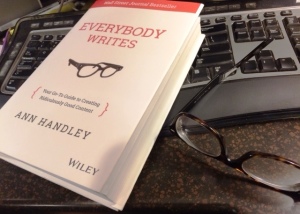
I write a lot. I also read a lot. But I think the last book I read about writing was Strunk and White’s The Elements of Style. (I know that dates me, but I have a point, so bear with me.)
As director of editorial services, I’m tasked with reviewing my colleagues’ written work to be sure it’s grammatically correct and as tight as possible. My colleagues depend on me to catch mistakes and push them to tell stories in the most engaging ways.
A couple of things make this part of my job tough. First, my colleagues are all amazing writers. There are many times I’ll shoot back, “Looks good!” without making any changes. Second, I’m human. I’m far from a perfect writer — or editor, for that matter.
In the spirit of improving my own writing and editing skills, I decided I needed to think beyond reaching for my well-worn copy of The Associated Press Stylebook when I get stumped.
So when I read good reviews about another book about writing, Everybody Writes by Ann Handley (Wiley 2014), I decided it was time. I really like Handley’s style – conversational, straightforward and cheeky – and her imaginative approach to business writing for today.
The book lives up to its reviews. Handley sold me with her shout-out to The Elements of Style co-author E.B. White at the beginning of the book and his quote about writing at the end:
“A writer who waits for ideal conditions under which to work will die without putting a word on paper.”
In between are 74 bite-size chapters plus content tools that cover everything we modern-day writers need to know about creating stellar content in a time-challenged world.
Because I liked the book so much, I was excited to listen in on a NASDAQ media intelligence webinar featuring Handley earlier this month. Here are just five of the many useful nuggets I gleaned:
- Don’t just tell a story; tell a true story well. Start with the goal of telling the corporate story (i.e., writing for you) and then reframe it from the perspective of your audience. That means editing out jargon and corporate-speak as well as showing what your product/service does for the customer vs. describing what it is. Handley applies Stephen King’s advice here: “Write with the door closed, rewrite with the door open.”
- Remember that publishing is a privilege. Always keep in mind that no one has to read what you write, so make the experience not just enjoyable but relevant to the reader. That means respecting your audience by empathizing with them, inspiring them and giving them the tools they need to accomplish what they need to do.
- Establish brand tone and voice. This is a practice RoseComm has adopted for our clients. Tone and voice are simply the unique ways of expressing a brand’s personality and POV through words. It makes you stand apart from others in the same space.
- Practice writing every day. Make the commitment to build writing into your day. Use social media – twitter, blog or whatever – to warm up. Don’t wait for inspiration. There are “content moments” everywhere; you just have to be on the lookout for them. If digital workspaces like Evernote or Trello help you organize your ideas, use and refer to them for stimulation.
- Be innovative and intriguing when you pitch. Pique media’s interest with an opportunity for more insight into your news. Handley used the example of Lays’ “Do Us a Flavor” contest. The subject line drew her in: “What a Potato Chip Campaign Says about the New Role of CFOs” and then the offer of a Wharton-sponsored podcast featuring the CFO of PepsiCo Americas Foods grabbed her. She probably would have disregarded a mundane announcement that wasabi ginger was the winning chip flavor.
I also found Handley’s writing GPS super helpful. The easy-to-follow infographic presents 12 steps to producing useful and engaging content.
Everybody writes, but what inspires you to write well?
